Decoding the Spatial–Temporal Coupling Dynamics of Land Use Intensity and Balance in China’s Chengdu–Chongqing Economic Circle: A 1 km Grid-Based Analysis
Abstract
1. Introduction
2. Materials and Methods
2.1. Study Area
2.2. Data Sources and Processing
2.3. Methodology
2.3.1. Land Use Indicators Calculation
- (1)
- Land Use Intensity indicator (LUI)
- (2)
- Balance Degree of Land Use Structure indicator (BDLUS)
- (3)
- Coupling Coordination Degree indicator (CCD)
- (4)
- Computing platform
2.3.2. Emerging Spatiotemporal Hotspot Analysis
- (1)
- Spatiotemporal cube modeling
- (2)
- Getis-Ord Gi* spatiotemporal statistical model
2.3.3. BFAST Test
2.3.4. Geographical Detector
3. Results
3.1. Analysis of the Spatial and Temporal Characteristics of Land Use
3.2. Analysis of Cold and Hot Spot Spatial Patterns
3.2.1. Spatial Dfferentiation Characteristics of the Central Region
3.2.2. Edge Zone Spatial Response Pattern
3.3. Analysis of Trends in Land Use Changes
3.3.1. Nonlinear Trend Feature Analysis
3.3.2. Analysis of Temporal Features During Trend Breaks
3.4. Quantitative Analysis of Land Use Change
- (1)
- In terms of single-factor explanatory power (Figure 10), elevation is dominant among the three indicators. The elevation explanation power of LUI reached 0.503, 0.481, and 0.481 in 2000, 2010, and 2020, respectively (BDLUS: 0.034–0.041; CCD: 0.202–0.238), significantly higher than that of other factors. Through the comparison of the mean q-values of various factors, the driving factor ranking for LUI is elevation (0.489) > slope (0.455) > GDP (0.116) > nighttime light (0.081) > population density (0.070). For BDLUS, the ranking is elevation (0.037) > slope (0.027) > nighttime light (0.010) > population density (0.007) > GDP (0.006). In the case of CCD, the ranking is elevation (0.219) > slope (0.138) > GDP (0.043) > nighttime light (0.037) > population density (0.034). This indicates that topographic elements (elevation, slope) have a fundamental controlling effect on the evolution of land systems in the study area.
- (2)
- The two-factor interaction effect shows (Figure 11) that all indicators exhibit significant nonlinear enhancement characteristics. Between 2000 and 2020, the interaction of the nighttime light with other factors increased the explanatory power for LUI, BDLUS, and CCD by 11.18% to 219.49%, demonstrating a typical synergetic amplification effect. Among these, the interaction combinations of slope and elevation have the highest explanatory power for LUI and BDLUS (LUI: 0.571–0.596; BDLUS: 0.062–0.067). The dominant interaction combination of CCD evolves over time: in 2000, it was elevation × population density (0.246), in 2010 it shifted to elevation × GDP (0.227), and by 2020, it was represented as elevation × nighttime lights (0.295). It is noteworthy that the independent effect of terrain factors shows a decreasing trend, while the explanatory power of the interaction between nighttime lights and population density significantly increases, even reaching 219.49%. In 2020, the interactive effects with elevation contributed to the explanatory power of BDLUS and CCD, reaching 0.068 and 0.295, respectively. This phenomenon reveals that the factors of human activity (represented by nighttime light) are gradually becoming the core driving force behind the evolution of land systems, which may be closely related to the accelerated urbanization process and industrial restructuring in the study area.
4. Discussion
4.1. Theoretical Analysis of the Spatiotemporal Coupling Mechanism of Land Use
4.2. Interacting Effects of Multi-Scale Driving Mechanisms
4.3. Policy Implications of Spatial Governance
5. Conclusions
- (1)
- Multidimensional coupling assessment system evaluation results
- (2)
- Analysis of the composite driving mechanism of terrain and human activities
Author Contributions
Funding
Data Availability Statement
Acknowledgments
Conflicts of Interest
References
- Cheng, H. Evaluation and Analysis of High-Quality Development of New Urbanization Based on Intelligent Computing. Math. Probl. Eng. 2022, 2022, 6428970. [Google Scholar] [CrossRef]
- Wang, H.; Kong, X.; Luo, J.; Li, P.; Chen, X.; Xie, T. An Approach to Urban System Spatial Planning in Chengdu Chongqing Economic Circle Using Geospatial Big Data. Front. Earth Sci. 2023, 11, 1252597. [Google Scholar] [CrossRef]
- Ding, R.; Fu, J.; Zhang, Y.; Zhang, T.; Yin, J.; Du, Y.; Zhou, T.; Du, L. Research on the Evolution of the Economic Spatial Pattern of Urban Agglomeration and Its Influencing Factors, Evidence from the Chengdu-Chongqing Urban Agglomeration of China. Sustainability 2022, 14, 10969. [Google Scholar] [CrossRef]
- Wang, M.; Wang, L. Study on Land Use Change and Driving Force in Chengdu-Chongqing Urban Agglomeration. ITM Web Conf. 2022, 47, 03037. [Google Scholar] [CrossRef]
- Zeng, C.; He, J.; He, Q.; Mao, Y.; Yu, B. Assessment of Land Use Pattern and Landscape Ecological Risk in the Cheng-du-Chongqing Economic Circle, Southwestern China. Land 2022, 11, 659. [Google Scholar] [CrossRef]
- Zhong, Q.; Li, Z.; He, Y. Coupling Evaluation and Spatial-Temporal Evolution of Land Ecosystem Services and Economic-Social Development in a City Group: The Case Study of the Chengdu-Chongqing City Group. Int. J. Environ. Res. Public Health 2023, 20, 5095. [Google Scholar] [CrossRef]
- Liu, H.; Lu, G.; Luo, K.; Zong, H. Measurement and Spatio-Temporal Pattern Evolution of Urban-Rural Integration Development in the Chengdu-Chongqing Economic Circle. Land 2024, 13, 942. [Google Scholar] [CrossRef]
- Liu, J.; Jin, X.; Xu, W.; Gu, Z.; Yang, X.; Ren, J.; Fan, Y.; Zhou, Y. A New Framework of Land Use Efficiency for the Coordination Among Food, Economy and Ecology in Regional Development. Sci. Total Environ. 2019, 697, 135670. [Google Scholar] [CrossRef]
- Hu, J.; Huang, Y.; Du, J. The Impact of Urban Development Intensity on Ecological Carrying Capacity: A Case Study of Ecologically Fragile Areas. Int. J. Environ. Res. Public Health 2021, 18, 7094. [Google Scholar] [CrossRef]
- Tan, S.; Liu, Q.; Han, S. Spatial-Temporal Evolution of Coupling Relationship Between Land Development Intensity and Resources Environment Carrying Capacity in China. J. Environ. Manag. 2021, 301, 113778. [Google Scholar] [CrossRef]
- Sang, X.; Guo, Q.; Wu, X.; Fu, Y.; Xie, T.; He, C.; Zang, J. Intensity and Stationarity Analysis of Land Use Change Based on CART Algorithm. Sci. Rep. 2019, 9, 12239. [Google Scholar] [CrossRef]
- Felipe-Lucia, M.; Soliveres, S.; Penone, C.; Fischer, M.; Ammer, C.; Boch, S.; Boeddinghaus, R.; Bonkowski, M.; Buscot, F.; Fiore-Donno, A.; et al. Land-Use Intensity Alters Networks Between Biodiversity, Ecosystem Functions, and Services. Proc. Natl. Acad. Sci. USA 2020, 117, 28140–28149. [Google Scholar] [CrossRef]
- Zheng, W.; Ke, X.; Xiao, B.; Zhou, T. Optimising Land Use Allocation to Balance Ecosystem Services and Economic Benefits—A Case Study in Wuhan, China. J. Environ. Manag. 2019, 248, 109306. [Google Scholar] [CrossRef]
- Huo, J.; Shi, Z.; Zhu, W.; Xue, H.; Chen, X. A Multi-Scenario Simulation and Optimization of Land Use with a Markov–FLUS Coupling Model: A Case Study in Xiong′an New Area, China. Sustainability 2022, 14, 2425. [Google Scholar] [CrossRef]
- Cui, D.; Chen, X.; Xue, Y.; Li, R.; Zeng, W. An Integrated Approach to Investigate the Relationship of Coupling Coordination Between Social Economy and Water Environment on Urban Scale: A Case Study of Kunming. J. Environ. Manag. 2019, 234, 189–199. [Google Scholar] [CrossRef]
- Tepe, E. History, Neighborhood, and Proximity as Factors of Land-Use Change: A Dynamic Spatial Regression Model. Environ. Plan. B Urban Anal. City Sci. 2023, 51, 7–22. [Google Scholar] [CrossRef]
- Li, G.; Zhang, X. The Spatial-Temporal Characteristics and Driving Forces of the Coupled and Coordinated Development Between New Urbanization and Rural Revitalization. Sustainability 2023, 15, 16487. [Google Scholar] [CrossRef]
- Liu, X.; Liang, X.; Li, X.; Xu, X.; Ou, J.; Chen, Y.; Li, S.; Wang, S.; Pei, F. A Future Land Use Simulation Model (FLUS) for Simulating Multiple Land Use Scenarios by Coupling Human and Natural Effects. Landsc. Urban Plan. 2017, 168, 94–116. [Google Scholar] [CrossRef]
- Majumdar, D.; Biswas, A. Quantifying Land Surface Temperature Change from LISA Clusters: An Alternative Approach to Identifying Urban Land Use Transformation. Landsc. Urban Plann. 2016, 153, 51–65. [Google Scholar] [CrossRef]
- Fang, C.; Li, G.; Wang, S. Changing and Differentiated Urban Landscape in China: Spatiotemporal Patterns and Driving Forces. Environ. Sci. Technol. 2016, 50, 2217–2227. [Google Scholar] [CrossRef]
- Gao, Y.; Wang, Z.; Xu, F. Geospatial Characteristics and the Application of Land Use Functions in the Yangtze River Economic Belt, China: Perspectives on Provinces and Urban Agglomerations. Ecol. Indic. 2023, 155, 110969. [Google Scholar] [CrossRef]
- Xue, Y.; Ma, W.; Liu, L.; Yang, Y. Land Use Evolution and Its Driving Factors over the Past 30 Years in Luochuan County. Forests 2024, 15, 1346. [Google Scholar] [CrossRef]
- Hoch, J.M.; Sutanudjaja, E.H.; Wanders, N.; van Beek, L.P.H.; Bierkens, M.F.P. Hyper-Resolution PCR-GLOBWB: Opportunities and Challenges from Refining Model Spatial Resolution to 1 km over the European Continent. Hydrol. Earth Syst. Sci. 2023, 27, 1383–1399. [Google Scholar] [CrossRef]
- Gao, J.; Pesaresi, M. Downscaling SSP-Consistent Global Spatial Urban Land Projections from 1/8-Degree to 1-km Resolution 2000–2100. Sci. Data 2021, 8, 281. [Google Scholar] [CrossRef]
- Li, X.; Chen, G.; Liu, X.; Liang, X.; Wang, S.; Chen, Y.; Pei, F.; Xu, X. A New Global Land-Use and Land-Cover Change Product at a 1-km Resolution for 2010 to 2100 Based on Human-Environment Interactions. Ann. Am. Assoc. Geogr. 2017, 107, 1040–1059. [Google Scholar] [CrossRef]
- Luo, M.; Hu, G.; Chen, G.; Liu, X.; Hou, H.; Li, X. 1 km Land Use/Land Cover Change of China Under Comprehensive Socioeconomic and Climate Scenarios for 2020–2100. Sci. Data 2022, 9, s41597-022-01204-w. [Google Scholar] [CrossRef]
- Dong, X.; Ye, Y.; Yang, R.; Li, X. Planning for Green Infrastructure Based on Integration of Multi-Driving Factors: A Case Study in Pilot Site of Sponge City. Sustain. Cities Soc. 2023, 102, 104549. [Google Scholar] [CrossRef]
- Masroor, M.; Avtar, R.; Sajjad, H.; Choudhari, P.; Kulimushi, L.; Khedher, K.; Komolafe, A.; Yunus, A.; Sahu, N. Assessing the Influence of Land Use/Land Cover Alteration on Climate Variability: An Analysis in the Aurangabad District of Maharashtra State, India. Sustainability 2022, 14, 642. [Google Scholar] [CrossRef]
- Chen, Y.; Wang, J.; Xiong, N.; Sun, L.; Xu, J. Impacts of Land Use Changes on Net Primary Productivity in Urban Agglomerations under Multi-Scenarios Simulation. Remote Sens. 2022, 14, 1755. [Google Scholar] [CrossRef]
- Verbesselt, J.; Hyndman, R.; Newnham, G.; Culvenor, D. Detecting Trend and Seasonal Changes in Satellite Image Time Series. Remote Sens. Environ. 2010, 114, 106–115. [Google Scholar] [CrossRef]
- Hutchinson, J.; Jacquin, A.; Hutchinson, S.; Verbesselt, J. Monitoring Vegetation Change and Dynamics on U.S. Army Training Lands Using Satellite Image Time Series Analysis. J. Environ. Manag. 2015, 150, 355–366. [Google Scholar] [CrossRef]
- Sun, F.; Zhang, N.; Hu, Y.; Tang, J. Research on the Urban Network Structure of the Chengdu-Chongqing Economic Circle from the Perspective of “Space of Flows”. World Reg. Stud. 2024, 33, 147–162. (In Chinese) [Google Scholar]
- Niu, Z.; Yang, X.; Chen, C.; Liao, X.; Zhang, X. Analysis of Urban Economic Development Characteristics in the Chengdu-Chongqing Urban Agglomeration Using Nighttime Light Remote Sensing. Nat. Resour. Remote Sens. 2024, 36, 272–281. [Google Scholar]
- Deng, Y.; Chen, H.; Hai, Y.; Zhou, J.; Ji, Z.; Luo, J.; Li, L. Spatial Pattern of Land Use Carbon Emissions and Carbon Balance Zoning in the Chengdu-Chongqing Twin-City Economic Circle. Bull. Soil Water Conserv. 2024, 44, 337–346. [Google Scholar] [CrossRef]
- Zhang, T.; Cheng, C.; Wu, X. Mapping the Spatial Heterogeneity of Global Land Use and Land Cover from 2020 to 2100 at a 1 km Resolution. Sci. Data 2023, 10, 1. [Google Scholar] [CrossRef]
- Zhang, X.; Liu, L.; Chen, X.; Gao, Y.; Xie, S.; Mi, J. GLC_FCS30: Global Land-Cover Product with Fine Classification System at 30 m Using Time-Series Landsat Imagery. Earth Syst. Sci. Data 2021, 13, 2753–2776. [Google Scholar] [CrossRef]
- Zhuang, D.; Liu, J. Modeling of Regional Differentiation of Land-Use Degree in China. Chin. Geogr. Sci. 1997, 7, 302–309. [Google Scholar] [CrossRef]
- Song, X.; Chen, F.; Sun, Y.; Ma, J.; Yang, Y.; Shi, G. Effects of Land Utilization Transformation on Ecosystem Services in Urban Agglomeration on the Northern Slope of the Tianshan Mountains, China. Ecol. Indic. 2024, 162, 112046. [Google Scholar] [CrossRef]
- Zhang, L.; Zhang, H.; Xu, E. Information Entropy and Elasticity Analysis of the Land Use Structure Change Influencing Eco-Environmental Quality in Qinghai-Tibet Plateau from 1990 to 2015. Environ. Sci. Pollut. Res. Int. 2022, 29, 18348–18364. [Google Scholar] [CrossRef] [PubMed]
- Pan, H.; Du, Z.; Wu, Z.; Zhang, H.; Ma, K. Assessing the Coupling Coordination Dynamics between Land Use Intensity and Ecosystem Services in Shanxi’s Coalfields, China. Ecol. Indic. 2024, 158, 111321. [Google Scholar] [CrossRef]
- Luo, S.; Wang, Y.; Huang, Y.; Mao, T. Research on the Coordinated Development of Tourism and Tourism Public Services from the Perspective of Coupling Coordination—A Case Study of 11 Counties in Guilin. J. Soc. Sci. Hunan Univ. Technol. 2023, 28, 42–50. [Google Scholar]
- Chen, H.; Wang, Z.; Feng, C.; Luo, Y. Research on Energy-Economy-Environment-Technology Coupling in Resource-Based Cities: A Case Study of Panzhihua. Conserv. Util. Miner. Resour. 2018, 5, 94–105. [Google Scholar]
- Gorelick, N.; Hancher, M.; Dixon, M.; Ilyushchenko, S.; Thau, D.; Moore, R. Google Earth Engine: Planetary-Scale Geospatial Analysis for Everyone. Remote Sens. Environ. 2017, 202, 18–27. [Google Scholar] [CrossRef]
- Ahmadi, H.; Argany, M.; Ghanbari, A.; Ahmadi, M. Visualized Spatiotemporal Data Mining in Investigation of Urmia Lake Drought Effects on Increasing of PM10 in Tabriz Using Space-Time Cube (2004–2019). Sustain. Cities Soc. 2022, 76, 103399. [Google Scholar] [CrossRef]
- Zhao, Y.; Ge, L.; Liu, J.; Liu, H.; Yu, L.; Wang, N.; Zhou, Y.; Ding, X. Analyzing Hemorrhagic Fever with Renal Syndrome in Hubei Province, China: A Space–Time Cube-Based Approach. J. Int. Med. Res. 2019, 47, 3371–3388. [Google Scholar] [CrossRef] [PubMed]
- Gao, F.; Li, S.; Tan, Z.; Liao, S. Visualizing the Spatiotemporal Characteristics of Dockless Bike Sharing Usage in Shenzhen, China. J. Geovis. Spat. Anal. 2022, 6, 12. [Google Scholar] [CrossRef]
- Yoon, J.; Lee, S. Spatio-Temporal Patterns in Pedestrian Crashes and Their Determining Factors: Application of a Space-Time Cube Analysis Model. Accid. Anal. Prev. 2021, 161, 106291. [Google Scholar] [CrossRef]
- Mendes, M.P.; Rodriguez-Galiano, V.; and Aragones, D. Evaluating the BFAST Method to Detect and Characterise Changing Trends in Water Time Series: A Case Study on the Impact of Droughts on the Mediterranean Climate. Sci. Total Environ. 2022, 846, 157428. [Google Scholar] [CrossRef]
- Liu, B.; Fang, X.; He, Q.; Rong, Q. Vegetation Change Monitoring Based on MODIS Data and BFAST Method. Remote Sens. Land Resour. 2016, 28, 146–153. [Google Scholar]
- Jong, R.D.; Verbesselt, J.; Zeileis, A.; Schaepman, M.E. Shifts in Global Vegetation Activity Trends. Remote Sens. 2013, 5, 1117–1133. [Google Scholar] [CrossRef]
- Higginbottom, T.P.; Symeonakis, E. Identifying Ecosystem Function Shifts in Africa Using Breakpoint Analysis of Long-Term NDVI and RUE Data. Remote Sens. 2020, 12, 1894. [Google Scholar] [CrossRef]
- Wang, J.F.; Xu, C.D. Geographical Detectors: Principles and Prospects. Acta Geogr. Sin. 2017, 72, 116–134. [Google Scholar] [CrossRef]
- Wang, H.; Gao, J.B.; Hou, W. Quantitative Attribution of Soil Erosion in Different Geomorphological Types of Karst Areas Based on Geographical Detector. J. Geogr. Sci. 2019, 29, 271–286. [Google Scholar] [CrossRef]
- Ling, Y.I.; Xiong, L.Y.; Yang, X.H. Method of pixelizing GDP data based on the GIS [dataset]. J. Gansu Sci. [CrossRef]
- Liu, H.Y.; Jiang, D.; Yang, X.H.; Luo, C. Spatialization Approach to 1km Grid GDP Supported by Remote Sensing. Geoinf. Sci. 2005, 7, 120–123. [Google Scholar]
- Zhang, H.; Dong, G.; Wang, J.; Zhang, T.-L.; Meng, X.; Yang, D.; Liu, Y.; Lu, B. Understanding and Extending the Geographical Detector Model under a Linear Regression Framework. Int. J. Geogr. Inf. Sci. 2023, 37, 2437–2453. [Google Scholar] [CrossRef]
- Shu, J. Research on the Evolution Characteristics and Influencing Factors of Ecological Land in Chengdu-Chongqing Urban Agglomeration. In Proceedings of the 2021 China Urban Planning Annual Conference (08 Urban Ecological Planning), Huazhong University of Science and Technology, Wuhan, China, 25 September 2021; pp. 56–65. [Google Scholar] [CrossRef]
- Zheng, H.; He, Y. How Does Industrial Co-Agglomeration Affect High-Quality Economic Development? Evidence from Chengdu-Chongqing Economic Circle in China. J. Clean. Prod. 2022, 371, 133485. [Google Scholar] [CrossRef]
- Xu, Z. Towards Carbon Neutrality in China: A Systematic Identification of China’s Sustainable Land-Use Pathways across Multiple Scales. Sustain. Prod. Consum. 2024, 44, 167–178. [Google Scholar] [CrossRef]
- Sun, P.J.; Liu, J.; Luo, N.; Peng, Y.L. Spatial Pattern and Influencing Factors of Shrinking Cities in Chengdu-Chongqing Twin Cities Economic Circle: Analysis Based on the Fifth, Sixth and Seventh National Population Census Data. J. Southwest Univ. (Nat. Sci. Ed.) 2022, 44, 46–56. [Google Scholar] [CrossRef]
- Wu, W.; Dang, Y.; Zhao, K.; Chen, Z.; Niu, X. Spatial Nonlinear Effects of Urban Vitality Under the Constraints of Development Intensity and Functional Diversity. Alex. Eng. J. 2023, 77, 645–656. [Google Scholar] [CrossRef]
- Chen, W.; Zeng, J.; Li, N. Change in Land-Use Structure Due to Urbanisation in China. J. Clean. Prod. 2021, 322, 128986. [Google Scholar] [CrossRef]
- Fosgerau, M.; Kim, J.; Ranjan, A. Vickrey Meets Alonso: Commute Scheduling and Congestion in a Monocentric City. SSRN 2018, 105, 40–53. [Google Scholar] [CrossRef]
- Růžička, M.; Mišovičová, R. The General and Special Principles in Landscape Ecology. Ekol. Bratisl. 2009, 28, 1–6. [Google Scholar] [CrossRef]
- Guo, Z.; Li, Z.; Lu, C.; She, J.; Zhou, Y. Spatio-Temporal Evolution of Resilience: The Case of the Chengdu-Chongqing Urban Agglomeration in China. Cities 2024, 153, 105226. [Google Scholar] [CrossRef]
- Meijers, E. Polycentric Urban Regions and the Quest for Synergy: Is a Network of Cities More than the Sum of the Parts? Urban Stud. 2005, 42, 765–781. [Google Scholar] [CrossRef]
- Lu, H.; Zhang, C.; Jiao, L.; Wei, Y.; Zhang, Y. Analysis on the Spatial-Temporal Evolution of Urban Agglomeration Resilience: A Case Study in Chengdu-Chongqing Urban Agglomeration, China. Int. J. Disaster Risk Reduct. 2022, 79, 103167. [Google Scholar] [CrossRef]
- Yang, C.; Li, Q.; Hu, Z.; Chen, J.; Shi, T.; Ding, K.; Wu, G. Spatiotemporal Evolution of Urban Agglomerations in Four Major Bay Areas of US, China and Japan from 1987 to 2017: Evidence from Remote Sensing Images. Sci. Total Environ. 2019, 671, 232–247. [Google Scholar] [CrossRef]
- Alario, M. Urban and Ecological Planning in Chicago: Science, Policy and Dissent. J. Environ. Plan. Manag. 2000, 43, 489–504. [Google Scholar] [CrossRef]
- Li, H.; Farnsworth, A.; Liang, D. Eco-metropolis: Re-interpreting ecological conservation in the context of innovative agglomeration. Environ. Sci. Ecotechnol. 2023, 19, 100342. [Google Scholar] [CrossRef]
- Balsas, C.J.L. GIS Buildout Analysis and Urban Planning. Chin. J. Urban Environ. Stud. 2021, 9, 2150006. [Google Scholar] [CrossRef]
- Tu, D.; Cai, Y.; Liu, M. Coupling coordination analysis and spatiotemporal heterogeneity between ecosystem services and new-type urbanization: A case study of the Yangtze River Economic Belt in China. Ecol. Indic. 2023, 154, 110535. [Google Scholar] [CrossRef]
- Zhao, J.; Zhao, Y. Synergy/trade-offs and differential optimization of production, living, and ecological functions in the Yangtze River Economic Belt, China. Ecol. Indic. 2023, 147, 109925. [Google Scholar] [CrossRef]
- Wang, C.X.; Chen, J.; Wan, Y.; Miao, G.H.; Liu, K.L.; Yi, T. Research on the spatial pattern and coupling coordination level of transportation and economic development in the Chengdu-Chongqing Twin Cities Economic Circle. Transp. Res. 2023, 9, 82–90. [Google Scholar] [CrossRef]
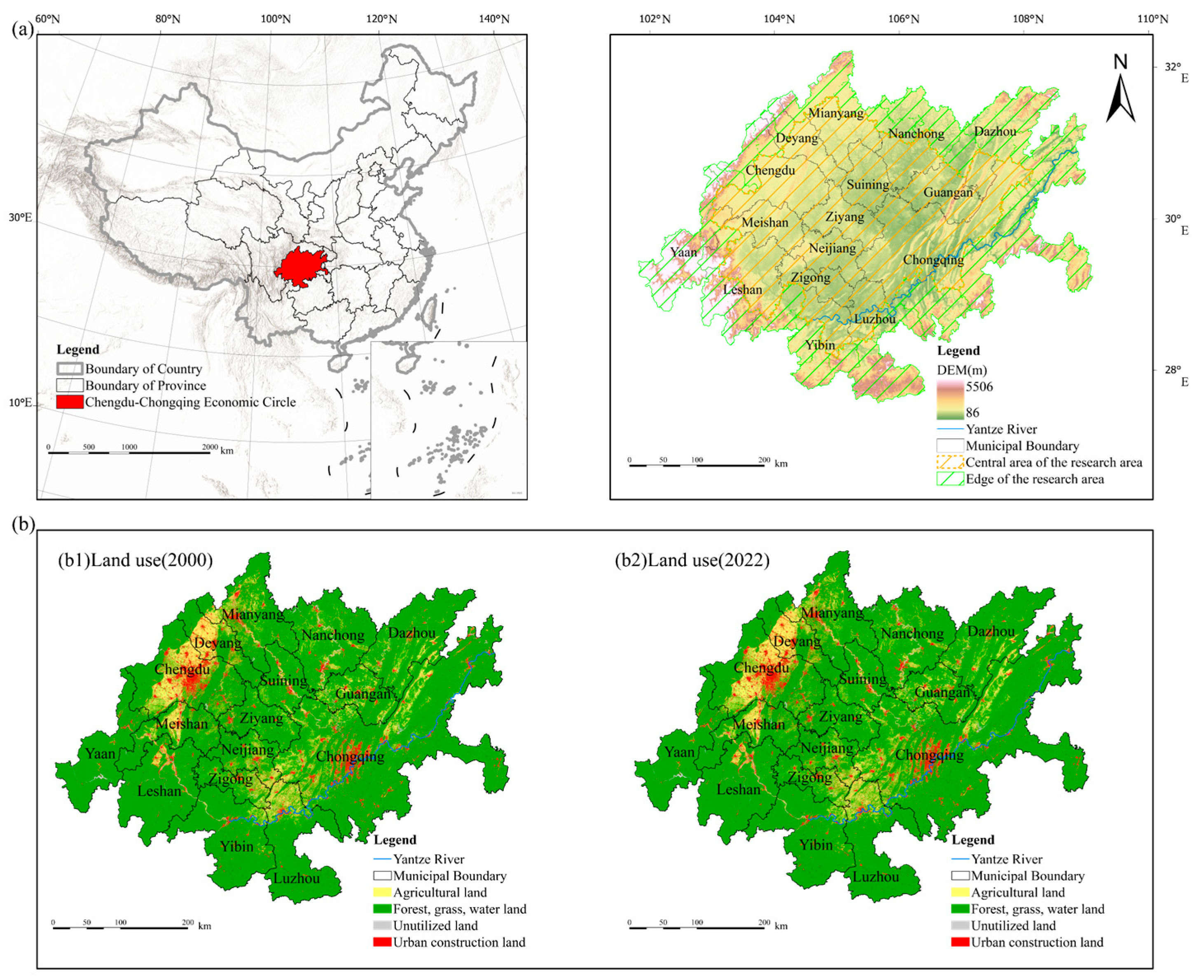
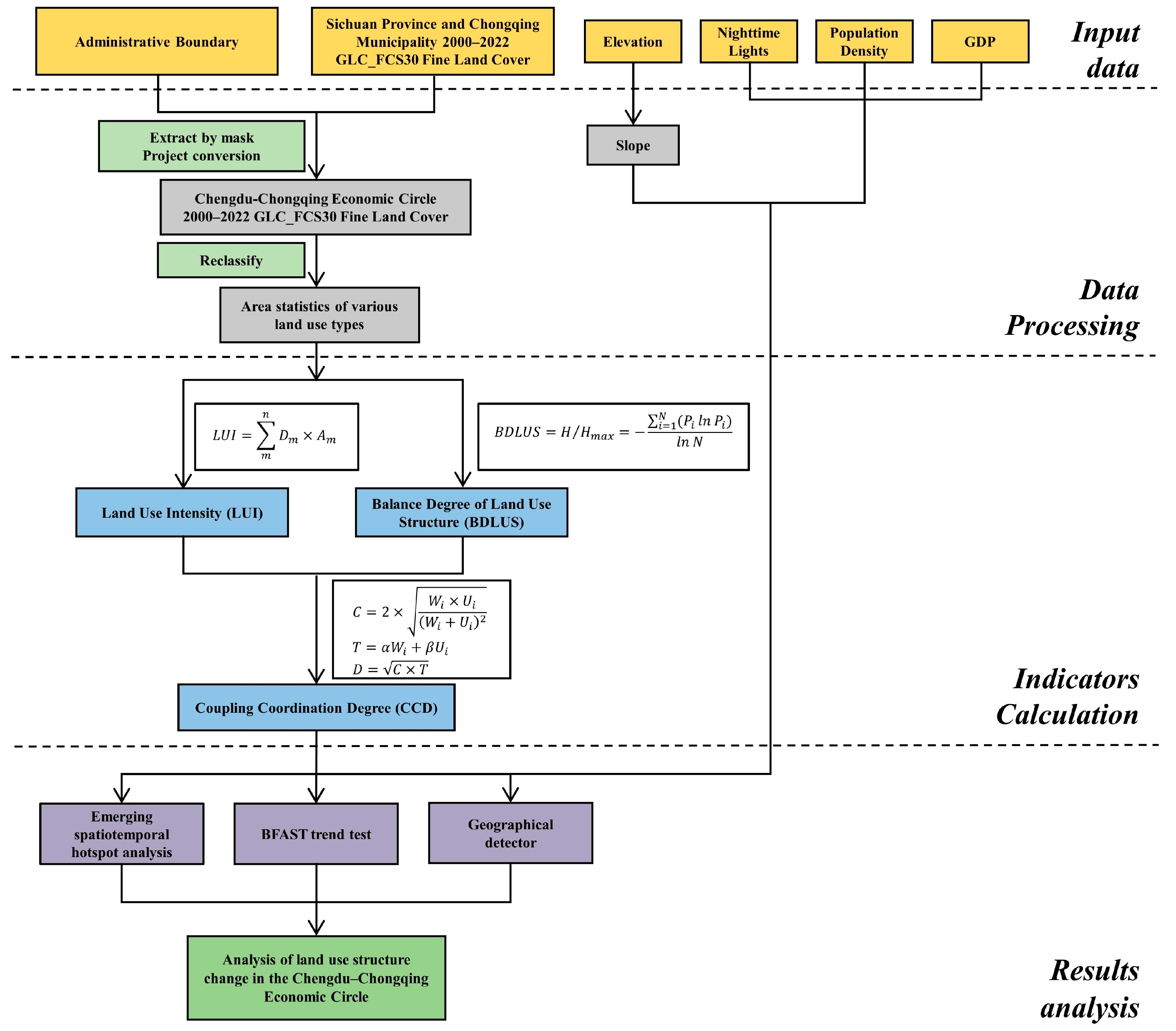
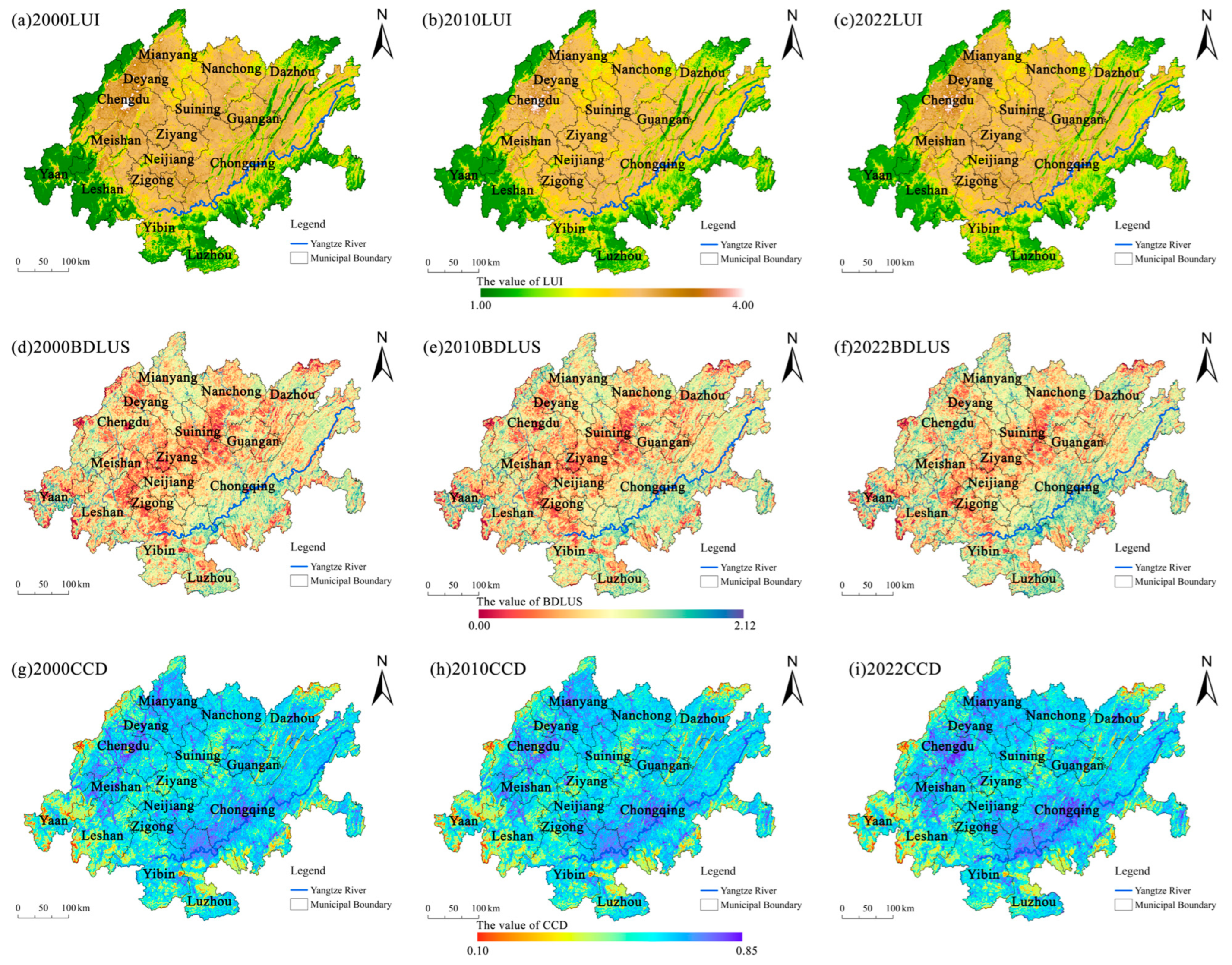
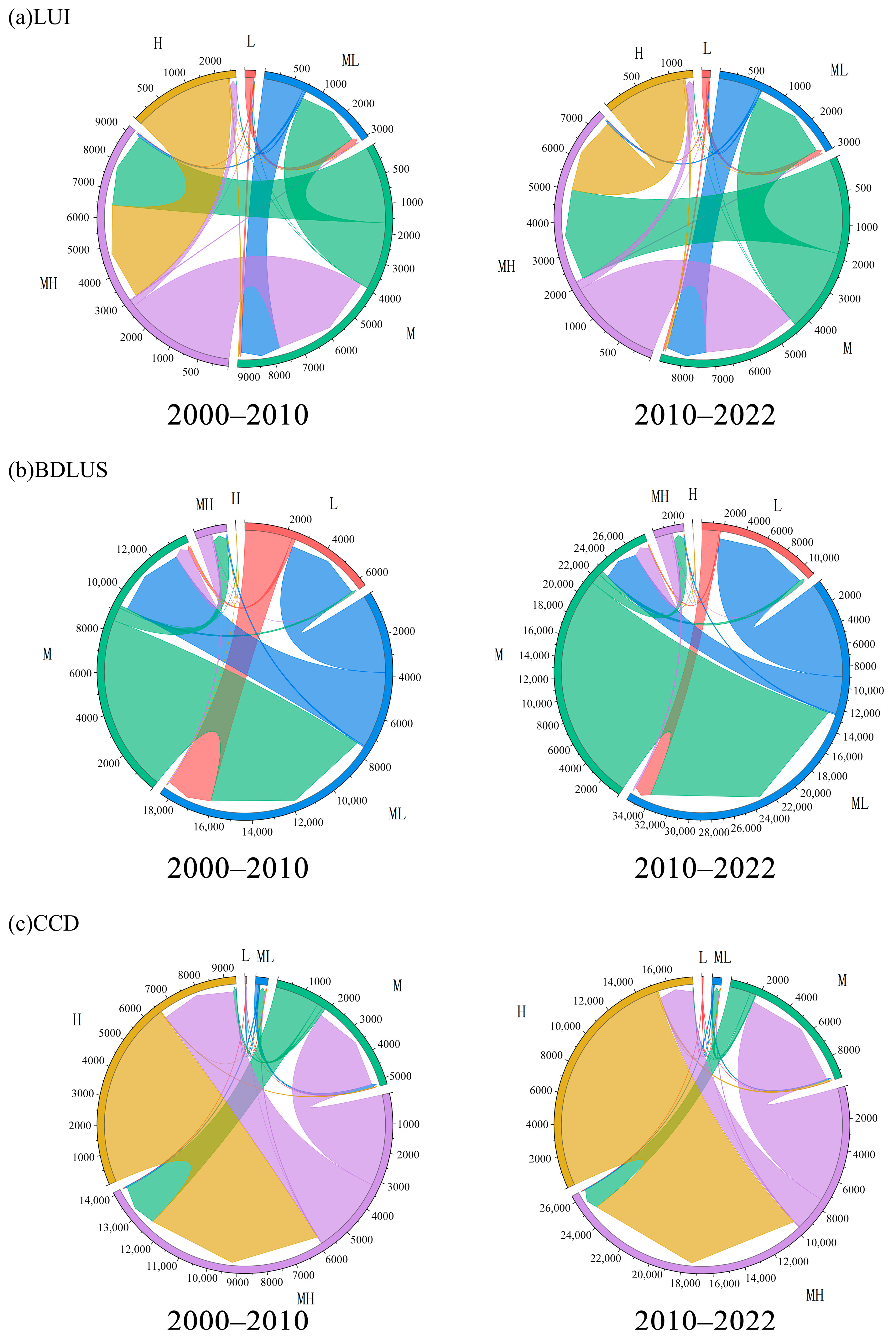
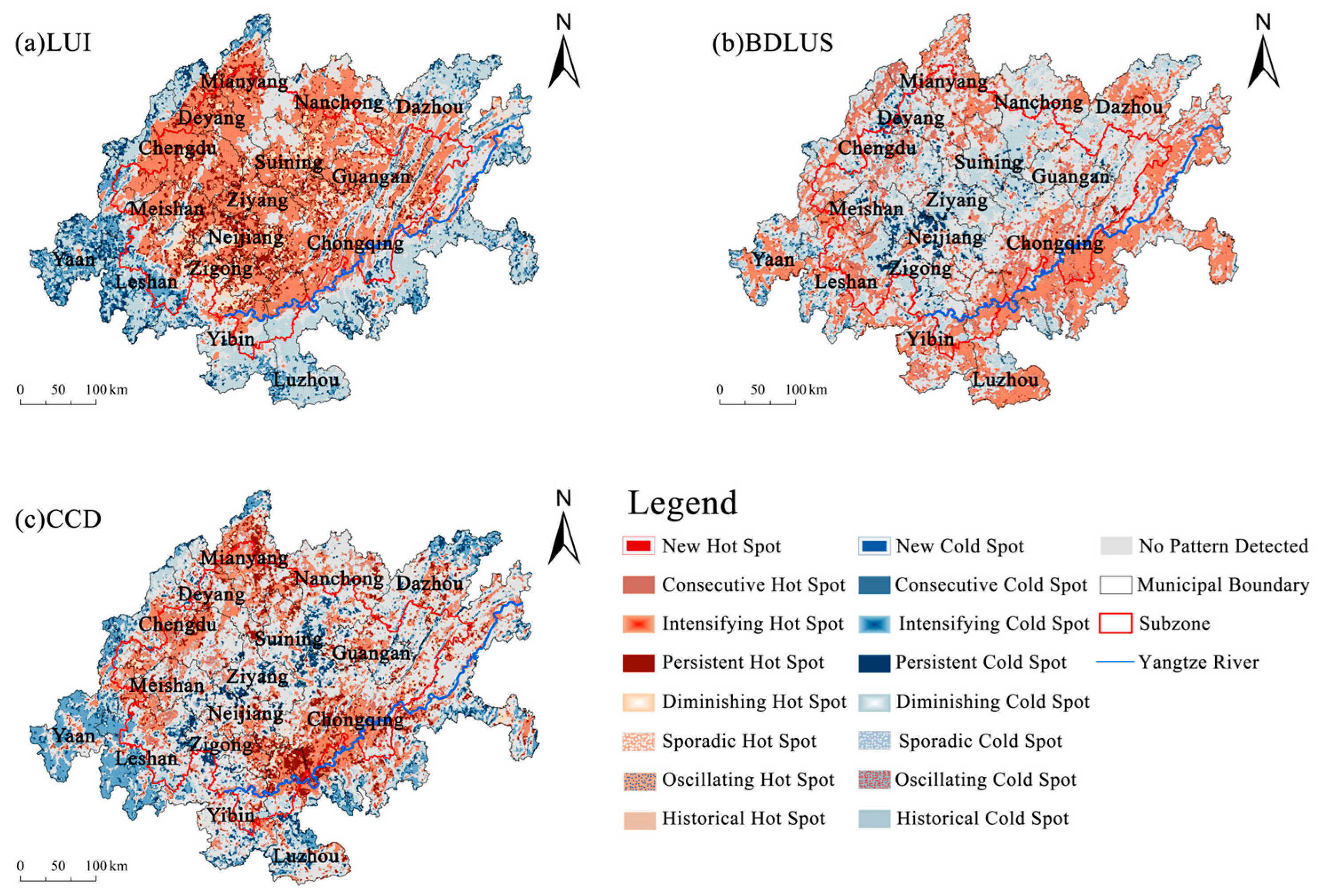
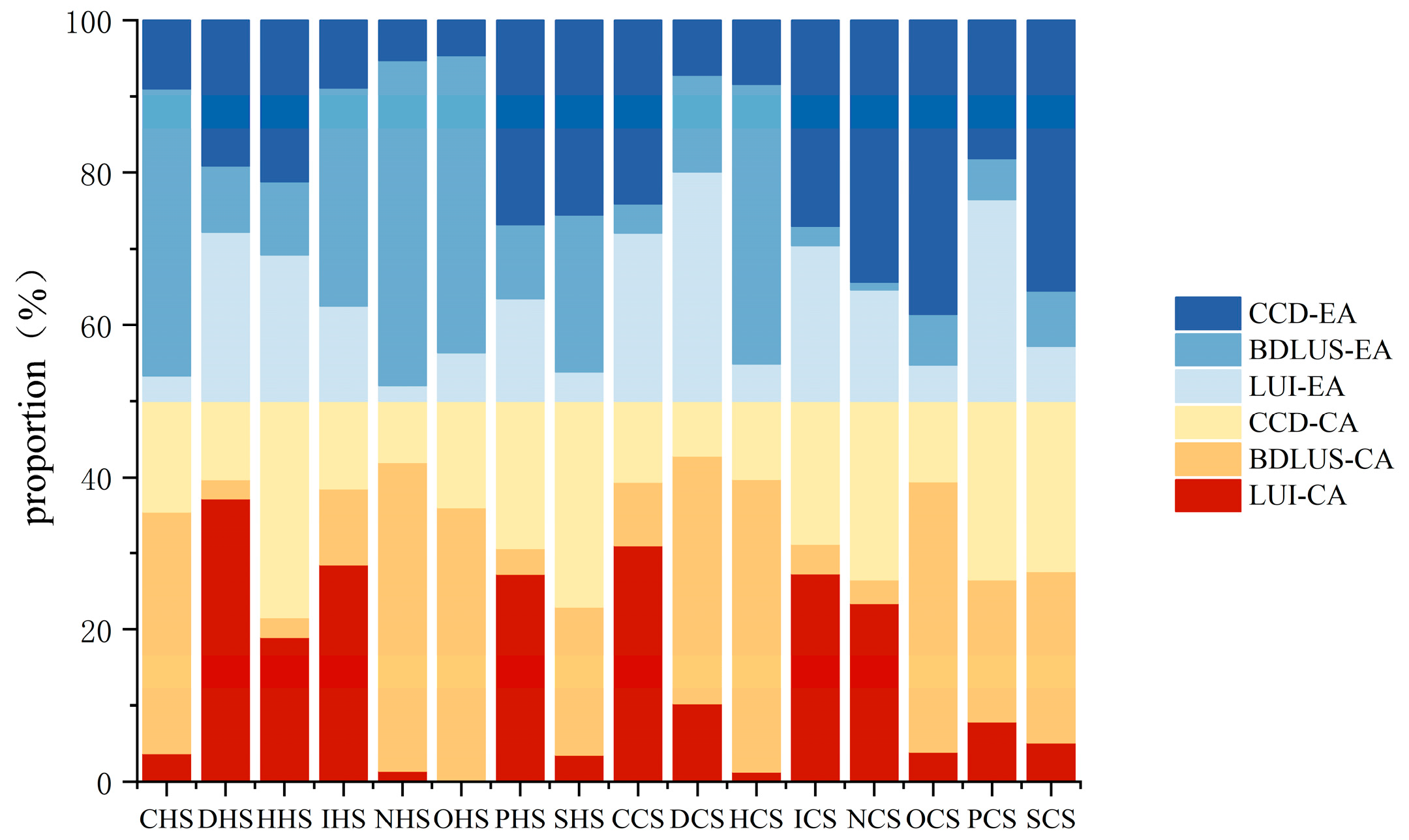
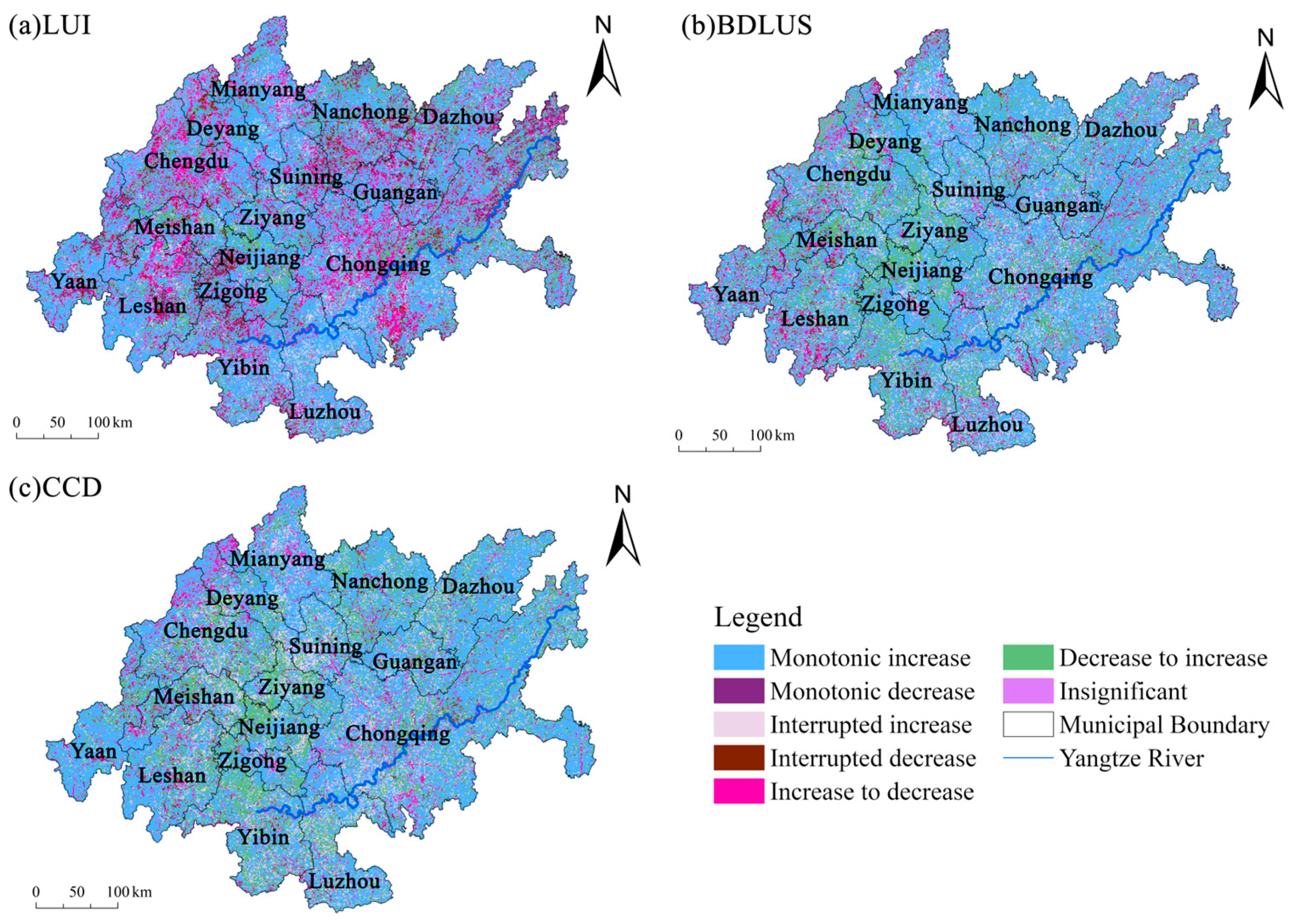
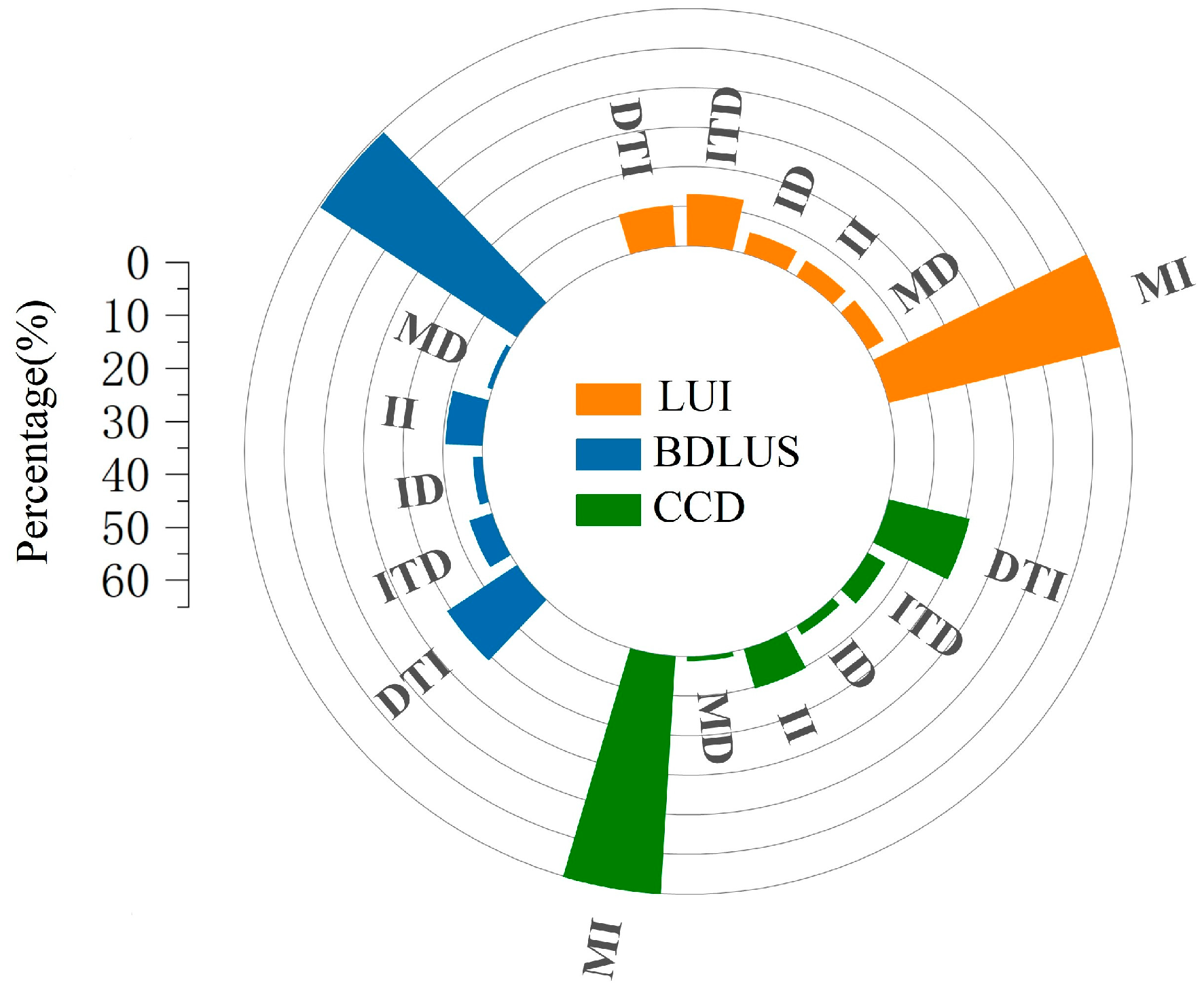
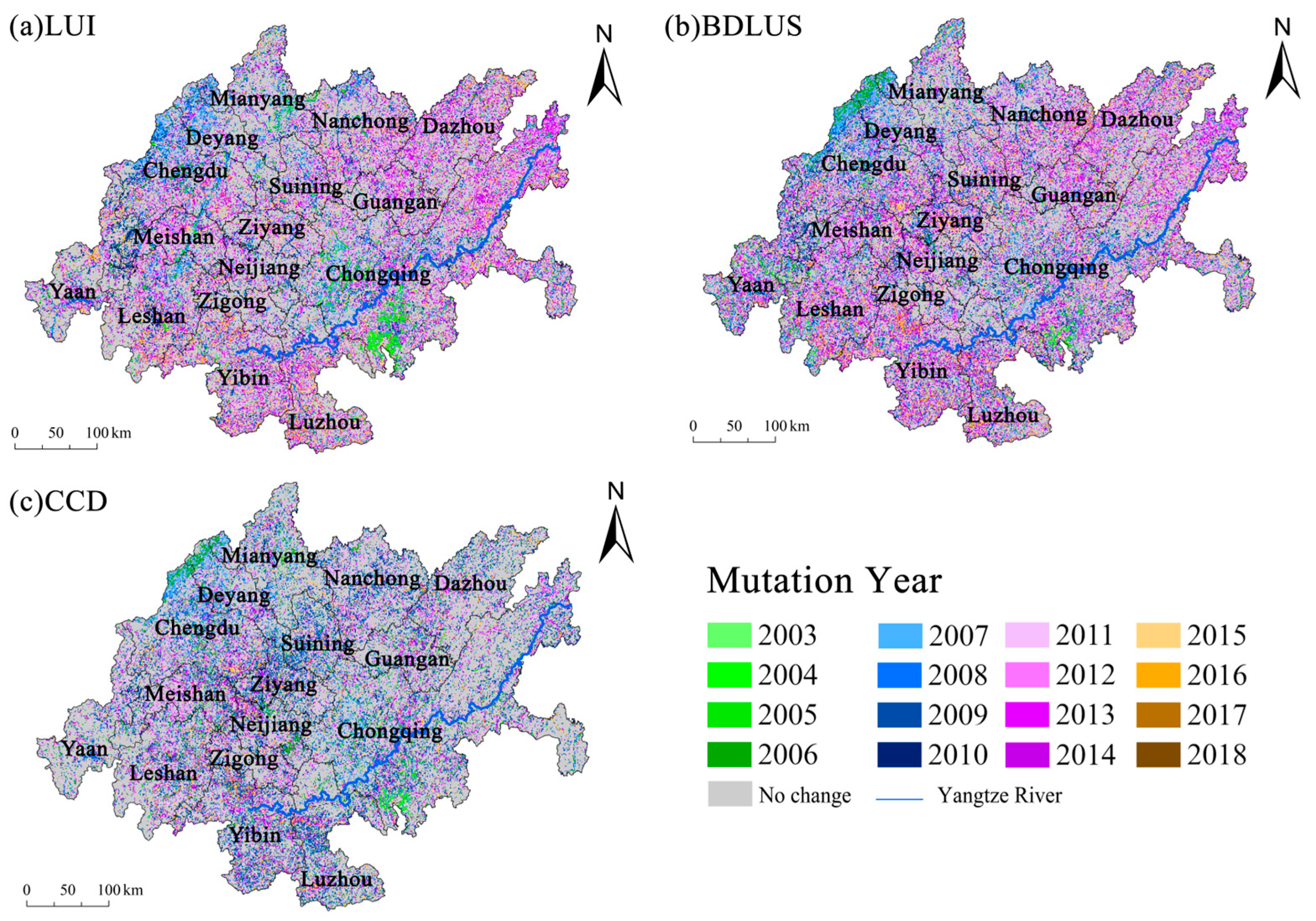
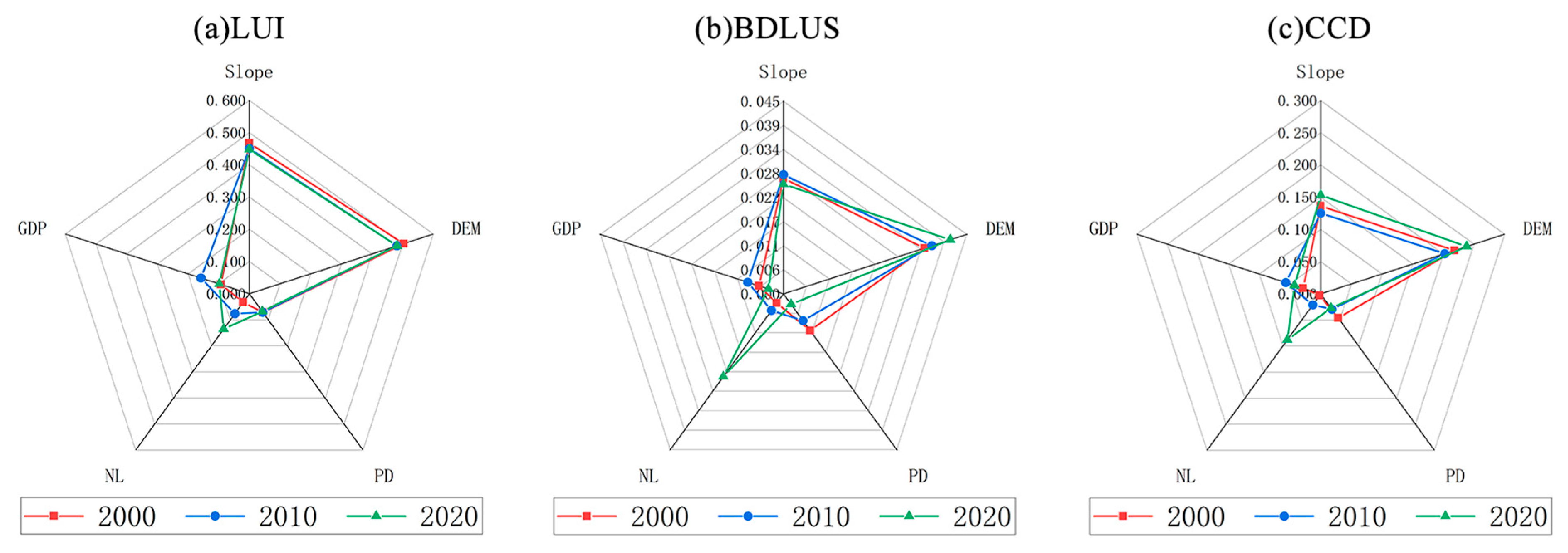
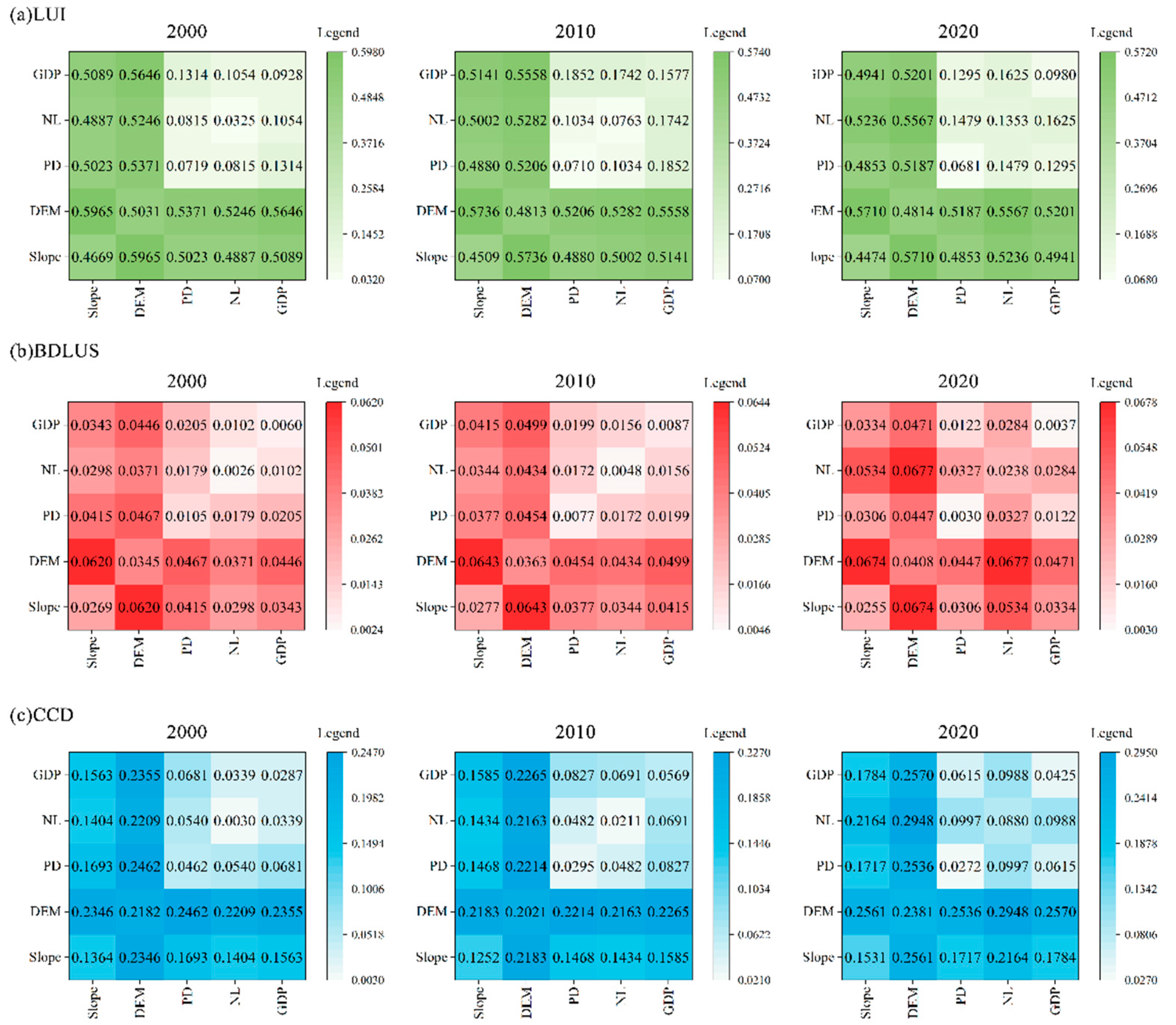
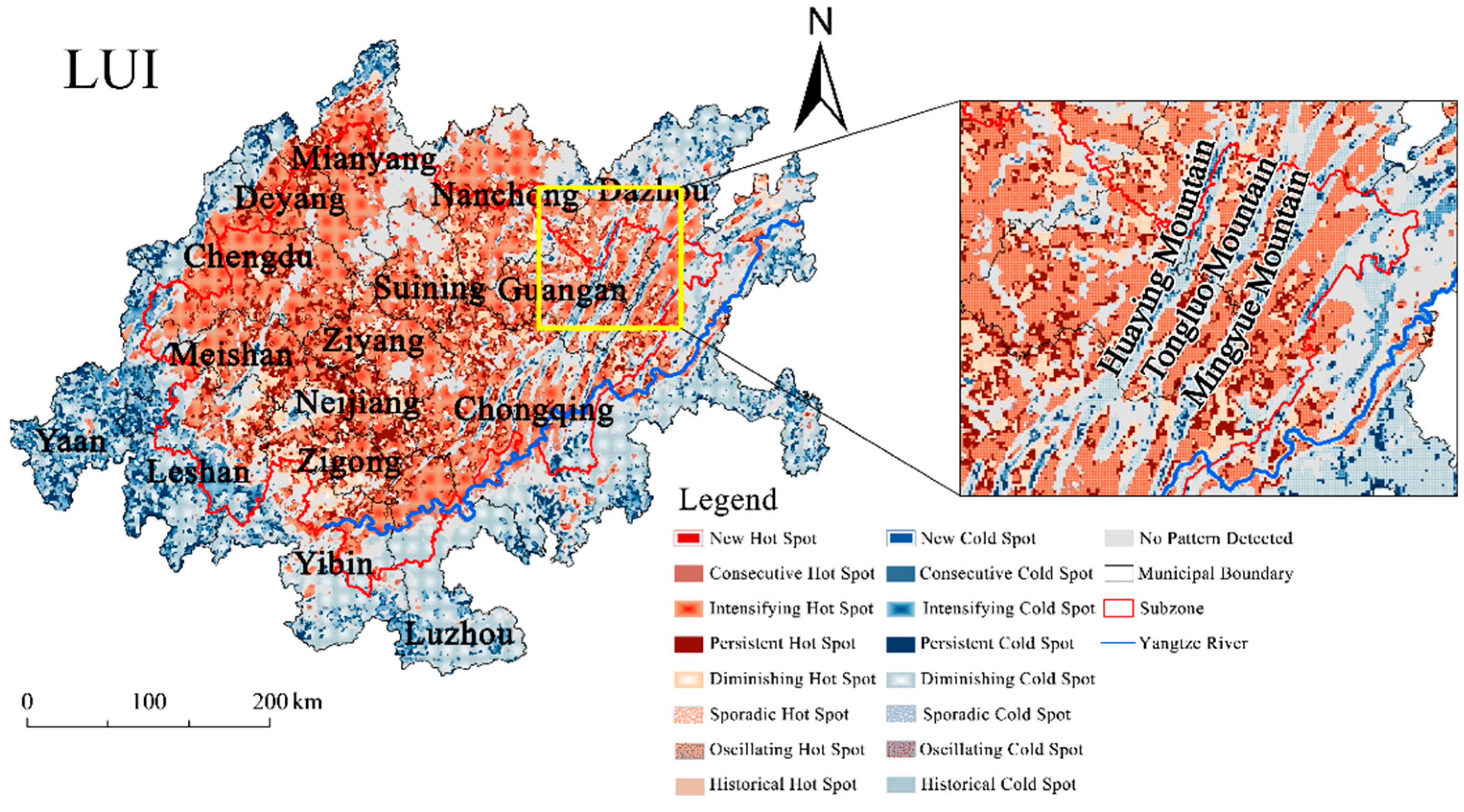
| Data Type | Data Name | Time Cross-Section (Year) | Spatial Resolution | Data Source |
|---|---|---|---|---|
| Land Use Data | GLC_FCS30 Fine Land Cover | 2000–2022 | 30 m | CASEarth Thematic Data System (https://data.casearth.cn/thematic/glc_fcs30/314, accessed on 15 March 2024) |
| Human Activity Data | Nighttime lights | 2000–2020 | 500 m | National Earth System Science Data Center, National Science and Technology Infrastructure of China (http://www.geodata.cn) |
| GDP | 1 km | Resource Environment Science and Data Platform (https://www.resdc.cn) | ||
| Population density | 30 arc seconds | GlobPOP Dataset (https://zenodo.org/records/11071404, accessed on 12 July 2024) | ||
| Terrain Data | Elevation | 2022 | 30 m | Resource Environment Science and Data Platform (https://www.resdc.cn) |
| Administrative Boundary Data | Administrative boundary | 2020 | 1:1,000,000 | National Geographic Information Resource Directory Service System (https://www.webmap.cn) |
| LC Id | Classification System | Assignment | LC Id | Classification System | Assignment |
|---|---|---|---|---|---|
| 10 | Rainfed cropland | 3 | 140 | Lichens and mosses | 2 |
| 11 | Herbaceous cover cropland | 2 | 150 | Sparse vegetation (fc < 0.15) | 2 |
| 12 | Tree or shrub cover (Orchard) cropland | 2 | 152 | Sparse shrubland (fc < 0.15) | 2 |
| 20 | Irrigated cropland | 3 | 153 | Sparse herbaceous (fc < 0.15) | 2 |
| 51 | Open evergreen broadleaved forest | 2 | 181 | Swamp | 1 |
| 52 | Closed evergreen broadleaved forest | 2 | 182 | Marsh | 1 |
| 61 | Open deciduous broadleaved forest (0.15 < fc < 0.4) | 2 | 183 | Flooded flat | 1 |
| 62 | Closed deciduous broadleaved forest (fc > 0.4) | 2 | 184 | Saline | 1 |
| 71 | Open evergreen needle-leaved forest (0.15 < fc < 0.4) | 2 | 185 | Mangrove | 2 |
| 72 | Closed evergreen needle-leaved forest (fc > 0.4) | 2 | 186 | Salt marsh | 1 |
| 81 | Open deciduous needle-leaved forest (0.15 < fc < 0.4) | 2 | 187 | Tidal flat | 1 |
| 82 | Closed deciduous needle-leaved forest (fc > 0.4) | 2 | 190 | Impervious surfaces | 4 |
| 91 | Open mixed leaf forest (broadleaved and needle-leaved) | 2 | 200 | Bare areas | 1 |
| 92 | Closed mixed leaf forest (broadleaved and needle-leaved) | 2 | 201 | Consolidated bare areas | 1 |
| 120 | Shrubland | 2 | 202 | Unconsolidated bare areas | 1 |
| 121 | Evergreen shrubland | 2 | 210 | Water body | 1 |
| 122 | Deciduous shrubland | 2 | 220 | Permanent ice and snow | 1 |
| 130 | Grassland | 2 | 0, 250 | Filled value | 0 |
| Type | Unused Land Level | Forest, Grassland, and Water Land Level | Agricultural Land Level | Town Settlement Land Level |
|---|---|---|---|---|
| Land use type | Unused or difficult-to-utilize land | Woodland, grassland, water area | Arable land, garden land, artificial turf | Urban areas, residential areas, industrial and mining land, transportation land |
| Graded Index | 1 | 2 | 3 | 4 |
| Type Name | Meanings |
|---|---|
| Monotonic increase (MI) | No obvious mutations were detected, or one obvious mutation was detected; the overall trend shows a monotonic increase. |
| Monotonic decrease (MD) | No obvious mutations were detected, or one obvious mutation was detected; the overall trend shows a monotonic decrease. |
| Interrupted increase (II) | A significant mutation was detected, with the trend showing a significant negative disturbance during the increase. |
| Interrupted decrease (ID) | A significant mutation was detected, with the trend showing a significant positive disturbance during the reduction. |
| Increase to decrease (ITD) | Detected one significant mutation, with the trend shifting from an increase to a decrease. |
| Decrease to increase (DTI) | Detected one significant mutation, with the trend shifting from a decrease to an increase. |
| Criteria for Discrimination | Interaction |
|---|---|
| Nonlinear attenuation | |
| Single-factor nonlinear attenuation | |
| Dual factor enhancement | |
| Independence | |
| Nonlinear enhancement |
| Level | LUI | BDLUS | CCD |
|---|---|---|---|
| Low (L) | 1.00–1.60 | 0.00–0.50 | 0.10–0.26 |
| Medium–Low (ML) | 1.60–2.20 | 0.50–1.00 | 0.26–0.42 |
| Middle (M) | 2.20–2.80 | 1.00–1.50 | 0.42–0.58 |
| Medium–High (ML) | 2.80–3.40 | 1.50–2.00 | 0.58–0.74 |
| High (H) | 3.40–4.00 | 2.00–2.50 | 0.74–0.90 |
Disclaimer/Publisher’s Note: The statements, opinions and data contained in all publications are solely those of the individual author(s) and contributor(s) and not of MDPI and/or the editor(s). MDPI and/or the editor(s) disclaim responsibility for any injury to people or property resulting from any ideas, methods, instructions or products referred to in the content. |
© 2025 by the authors. Licensee MDPI, Basel, Switzerland. This article is an open access article distributed under the terms and conditions of the Creative Commons Attribution (CC BY) license (https://creativecommons.org/licenses/by/4.0/).
Share and Cite
Yan, Z.; Zhou, C.; Tang, Z.; Wang, H.; Li, H. Decoding the Spatial–Temporal Coupling Dynamics of Land Use Intensity and Balance in China’s Chengdu–Chongqing Economic Circle: A 1 km Grid-Based Analysis. Land 2025, 14, 1597. https://doi.org/10.3390/land14081597
Yan Z, Zhou C, Tang Z, Wang H, Li H. Decoding the Spatial–Temporal Coupling Dynamics of Land Use Intensity and Balance in China’s Chengdu–Chongqing Economic Circle: A 1 km Grid-Based Analysis. Land. 2025; 14(8):1597. https://doi.org/10.3390/land14081597
Chicago/Turabian StyleYan, Zijia, Chenxi Zhou, Ziyi Tang, Hanfei Wang, and Hao Li. 2025. "Decoding the Spatial–Temporal Coupling Dynamics of Land Use Intensity and Balance in China’s Chengdu–Chongqing Economic Circle: A 1 km Grid-Based Analysis" Land 14, no. 8: 1597. https://doi.org/10.3390/land14081597
APA StyleYan, Z., Zhou, C., Tang, Z., Wang, H., & Li, H. (2025). Decoding the Spatial–Temporal Coupling Dynamics of Land Use Intensity and Balance in China’s Chengdu–Chongqing Economic Circle: A 1 km Grid-Based Analysis. Land, 14(8), 1597. https://doi.org/10.3390/land14081597





